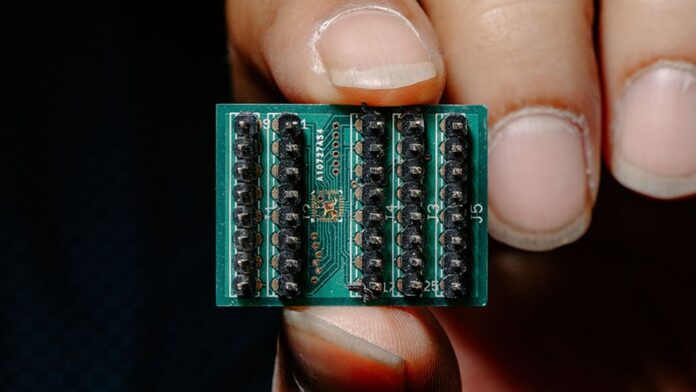Shreyas Sen, an Elmore Associate Professor of Electrical and Computer Engineering at Purdue University, is designing chips to enable AI to work offline for a network of wearable devices. Inspired by the human body’s nervous system, the chip is designed to transfer data at high speeds but ultra-low power levels.
The wearable devices we use to access the internet, including AI algorithms over the cloud, have chips with “brains” in the form of central processing units, but no “nerves.” Without having something to function as a peripheral nervous system, these “brains” in wearable devices use high-energy electromagnetic waves such as Bluetooth or Wi-Fi to send information to each other, which limits the battery life of these devices and prevents them from having the capability to support complex AI algorithms on-chip.
 Every Wednesday is Wearable Wednesday here at Adafruit! We’re bringing you the blinkiest, most fashionable, innovative, and useful wearables from around the web and in our own original projects featuring our wearable Arduino-compatible platform, FLORA. Be sure to post up your wearables projects in the forums or send us a link and you might be featured here on Wearable Wednesday!
Every Wednesday is Wearable Wednesday here at Adafruit! We’re bringing you the blinkiest, most fashionable, innovative, and useful wearables from around the web and in our own original projects featuring our wearable Arduino-compatible platform, FLORA. Be sure to post up your wearables projects in the forums or send us a link and you might be featured here on Wearable Wednesday!
Adafruit publishes a wide range of writing and video content, including interviews and reporting on the maker market and the wider technology world. Our standards page is intended as a guide to best practices that Adafruit uses, as well as an outline of the ethical standards Adafruit aspires to. While Adafruit is not an independent journalistic institution, Adafruit strives to be a fair, informative, and positive voice within the community – check it out here: adafruit.com/editorialstandards
Adafruit is on Mastodon, join in! adafruit.com/mastodon
Stop breadboarding and soldering – start making immediately! Adafruit’s Circuit Playground is jam-packed with LEDs, sensors, buttons, alligator clip pads and more. Build projects with Circuit Playground in a few minutes with the drag-and-drop MakeCode programming site, learn computer science using the CS Discoveries class on code.org, jump into CircuitPython to learn Python and hardware together, TinyGO, or even use the Arduino IDE. Circuit Playground Express is the newest and best Circuit Playground board, with support for CircuitPython, MakeCode, and Arduino. It has a powerful processor, 10 NeoPixels, mini speaker, InfraRed receive and transmit, two buttons, a switch, 14 alligator clip pads, and lots of sensors: capacitive touch, IR proximity, temperature, light, motion and sound. A whole wide world of electronics and coding is waiting for you, and it fits in the palm of your hand.
Have an amazing project to share? The Electronics Show and Tell is every Wednesday at 7pm ET! To join, head over to YouTube and check out the show’s live chat – we’ll post the link there.
Join us every Wednesday night at 8pm ET for Ask an Engineer!
Join over 36,000+ makers on Adafruit’s Discord channels and be part of the community! http://adafru.it/discord
CircuitPython – The easiest way to program microcontrollers – CircuitPython.org
No comments yet.
Adafruit has a “be excellent to each other” comment policy. Help us keep the community here positive and helpful. Stick to the topic, be respectful of makers of all ages and skill levels. Be kind, and don’t spam – Thank you!




